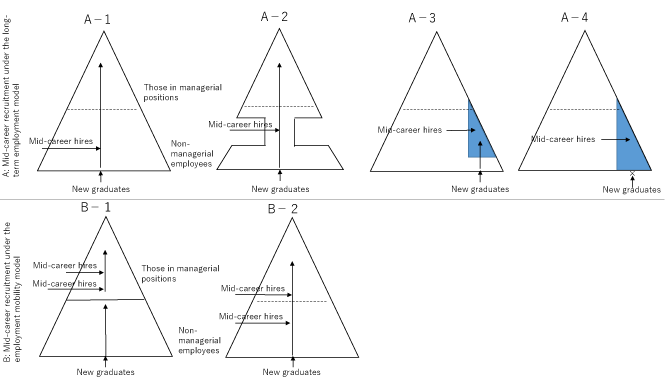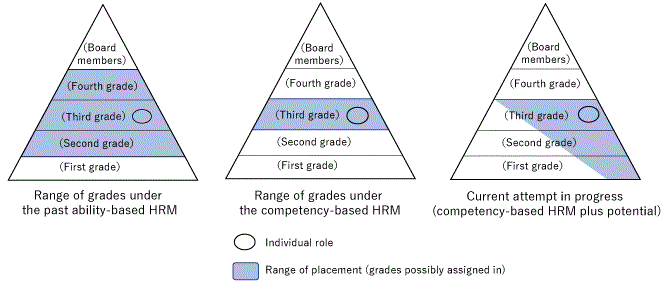JILPT Research Report No.220
The Current Situation and Future Direction of the Long-term Employment System in Japan: Focusing on Mid-career Recruitment and New Business Developments
March 31, 2022
Summary
Research Objective
This survey, targeting white-collar workers of large companies, defines an employment practice on the assumption of long-term job tenure (in which companies hire new graduates en masse, and retain personnel for long term to utilize their utmost skills and abilities) as the “long-term employment system,” and explores the current situation and its potential.
Research Method
Literature review and interview survey
Key Findings
- When classified patterns of mid-career recruitment in terms of companies’ needs of mid-career workers, six patterns are found as follows (Figure 1):
A-1: Filling the shortfall in hiring of new graduates
A-2: Adjusting the imbalance of the age structure of the workforce
A-3: Supplement until new graduate hires became fully-grown
A-4: Supplementary needs
B-1: Making greater use of mid-career hires in managerial positions constantly
B-2: Treating new graduate hires and mid-career hires equally
Among them, those fall into patterns in type A can be considered mid-career recruitment under the “long-term employment model,” and those fall into patterns in type B can be deemed as mid-career recruitment under the “employment mobility model.” - It is proved that an increase of mid-career hires has not pushed forward a shift from the long-term employment model to the employment mobility model. On the one hand, mid-career recruitment has become more prevalent, but at the same time, the trend which seeks to make the shift in their human resource management (HRM) from the long-term employment model in type A to the employment mobility model in type B has not been seen at least among the surveyed companies. These two models are thought to be independently coexisting side by side in the future. This suggests that those companies which utilize human resource under the long-term employment system do not mean to aim for shifting to other systems (in other words, mid-career recruitment in Japan has been used to a limited extent such as supplement for new graduates hires to maintain the long-term employment system or as recruitment for niche skills and expertise in specific areas). In this regard, the long-term employment system is expected to be maintained in the future.
- Meanwhile, some companies have been continually procuring and utilizing employees who play core roles through external labor market, but it turned out that hiring core employees outside the company has been the common practice of HRM of those companies since back in the day. For example, there exists companies in the service industry that fall into “B-1: Making greater use of mid-career hires in managerial positions constantly.” This suggests that the employment mobility model is certainly in existence in the service sector companies. Seen in that light, there is a prospect that utilizing human resource under the employment mobility model will be becoming mainstream depending on the future trends of the industrial structure.
Figure 1. Patterns of mid-career recruitment
Source: Prepared by the author.
- When analyzed the HRM that applied to employees who are responsible for high-risk business activities such as developments of new products or new services that are considered as the shortcomings of Japanese companies, some cases can be listed below:
- Long-term employment as a HRM policy.
- Separation of “ranks of positions according to grading system based on ability” and “ranks of employees based on job duties.”
- Implementation of behavior-based assessment of performance at work.
- Activation of communication within and/or across company.
- When selecting a responsible person of a new business, hand-picking a suitable employee for the position regardless of age or duration of employment.
- Since an assessment system that focuses on performance outcomes has a risk of not working well when it comes to constraints on individual risk-averse behaviors, putting more emphasis on behaviors rather than performance outcomes has been adopted. At the same time, when assigning high-risk business activities which requires “exploratory” behaviors to prospective personnel, those companies devise methods of personnel selection. Although each case varies in its details, they try to select an employee who has an idea that leads to develop a new business, and give him a position or authority as a responsible person who develop a new business activity. In doing so, they make an attempt to add his potential in the future to his accumulated achievements in the past within the company as a criterion of the selection.
- While maintaining the long-term employment system, the companies try to promote HRM that focuses on “potential” as a new perspective on abilities, which is different from the past “ability-based HRM” or the “competency-based HRM (which is designed after merit-based HR reform in Japan).” It can be stated that this is a new perspective on abilities that has become more important nowadays. With the change of the perspective on abilities, it is suggested that there has also been a change in the subject of selection (Figure 2). Through the “competency-based HRM,” while avoiding inefficiencies that arise from the past “ability-based HRM” (such as bearing the costs resulting from assigning lower-level roles to upper-ranked employees), but at the same time, along with taking into account the “potential” as a prospect in the future, they seek to improve the efficiency of the past “ability-based HRM” that has been diminished by the “competency-based HRM,” which means that they intend to create an environment that makes it easier to hand-pick employees from the “lower ranks.”
- It appears that the HRM which has the characteristics close to the ones that Japan has adopted to date, such as putting more emphasis on behaviors than separation of managerial positions and grades or performance outcomes, has become an appropriate system for both those engaged in non-clerical works responsible for operations of current businesses and those who play a founder's role for a new business development in their hiring company. With consideration of the circumstances of those founders, this HRM has been introduced in part not so much to develop vocational skills through internal job rotations like those conducted for blue-collar workers during 1980s, but to prevent interference to the activities of personnel who have the potential to sow the seed of business that could be profitable in the future and grow it. It could therefore be said that although the basic principles of the HRM systems are the same, the systems have been utilized while making changes to them on a flexible basis. In any case, given the characteristic of covering the both functions which are thought to be positioned at two extremes, for companies dealing with both current businesses and new businesses within their organizations, making choice of the modified version of an ability-based system can be considered reasonable to a certain extent. Since it is possible to run after two hares at a time and catch both of them, it seems that maintaining this system may not always be seen to be inefficient. Overall, it can be concluded that the ability-based HRM is considered to be rational to a certain level in sustaining activities which expected to cause changes to business operations within their organizations.
Figure 2. Rules of selecting personnel by perspective on abilities
Source: Prepared by the author.
Research Period
FY2017–2018
Authors (in alphabetical order; affiliation is as of the time of writing)
- FUJIMOTO Makoto
- Senior Researcher, The Japan Institute for Labour Policy and Training
- NISHIMURA Itaru
- Vice Senior Researcher, The Japan Institute for Labour Policy and Training
- UMEZAKI Osamu
- Professor, Faculty of Lifelong Learning and Career Studies, Hosei University
- YAMABE Masashi
- Assistant Fellow, The Japan Institute for Labour Policy and Training
Contents
- JILPT Research Report No.220, full text (PDF:3.9MB)[in Japanese]
Category
Working conditions / Work environment, Human resources management/vocational skills development
For Citation
JILPT. 2022. Choki kinzoku sisutemu no kanosei: Chuto saiyo to shinki jigyo kaihatsu ni chakumoku shite [The Current Situation and Future Direction of the Long-term Employment System in Japan: Focusing on Mid-career Recruitment and New Business Developments]. JILPT Research Report no.220. Tokyo: The Japan Institute for Labour Policy and Training.
Related Research Results
- Project Research Series No.4 on the JILPT 3rd Midterm Project, The Future of the Japanese-style Employment System (2017)
- JILPT Research Report No.210, The Future of the Japanese Long-Term Employment Society: The Consequences of Post-Industrialization and Increase of Unmarried Workers (2021)
- Discussion Paper 21-10, Nihon Kigyo ni okeru Jinji Seido Kaikaku no 30-nen-shi [A thirty-year history of personnel system reforms in Japanese companies] (2021)
- JILPT Research Report No.221, Changing Employment Society and its Vitality: Challenges of Work Styles Adapted to the Industrial Structure and Demographics (2022)
JILPT Research Report at a Glance
| To view PDF files, you will need Adobe Acrobat Reader Software installed on your computer.The Adobe Acrobat Reader can be downloaded from this banner. |

